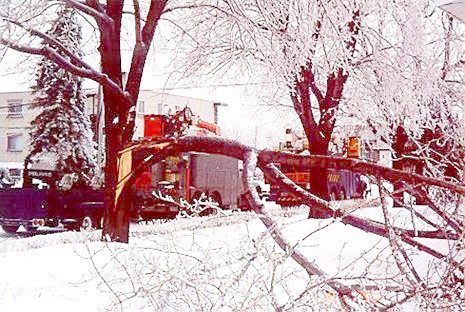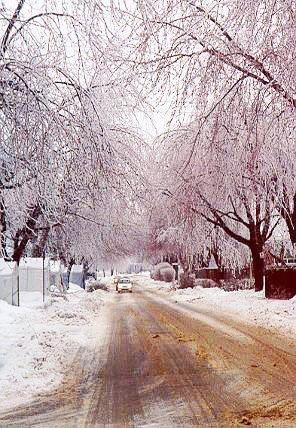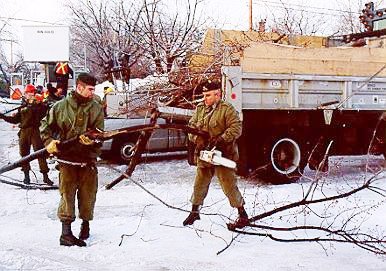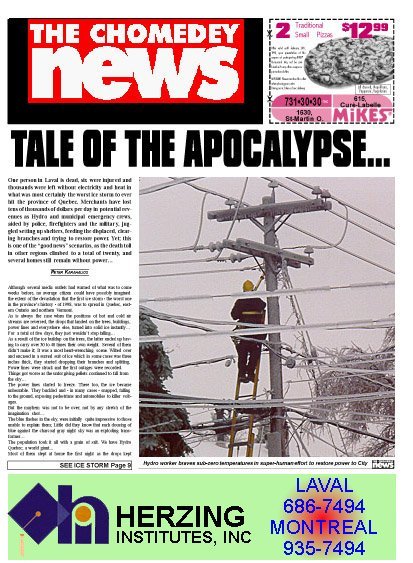(Ed. Note: In 1998 The Laval News -TLN- was published under the name The Chomedey News -TCN- due to its distribution only in the Chomedey area. Therefore, all TCN mentions in the article refer to the previous title name of The Laval News which is distributed throughout Laval).
BY PETER KARAHALIOS
One person in Laval is dead, six were injured and thousands were left without electricity and heat in what was most certainly the worst ice storm to ever hit the province of Quebec.

Merchants have lost tens of thousands of dollars per day in potential revenues as Hydro and municipal emergency crews, aided by police, firefighters and the military, juggled setting up shelters, feeding the displaced, clearing branches and trying to restore power. Yet; this is one of the “good news” scenarios, as the death toll in other regions climbed to a total of twenty, and several homes still remain without power…
Although several media outlets had warned of what was to come weeks before, no average citizen could have possibly imagined the extent of the devastation that the first ice storm – the worst one in the province’s history – of 1998, was to spread in Quebec, eastern Ontario and northern Vermont.
As is always the case when the positions of hot and cold air streams are reversed, the drops that landed on the trees, buildings, power lines and everywhere else, turned into solid ice instantly…
For a total of five days, they just wouldn’t stop falling…
As a result of the ice build-up on the trees, the latter ended up having to carry over 30 to 40 times their own weight. Several of them didn’t make it; It was a most heart-wrenching scene. Wilted over and encased in a surreal suit of ice which in some cases was three inches thick, they started dropping their branches and splitting. Power lines were struck and the first outages were recorded.
Things got worse as the unforgiving pellets continued to fall from the sky…
The power lines started to freeze. There too, the ice became unbearable. They buckled and – in many cases – snapped, falling to the ground, exposing pedestrians and automobiles to killer voltages. But the mayhem was not to be over; not by any stretch of the imagination shot… The blue flashes in the sky, were initially quite impressive to those unable to explain them; Little did they know that each dousing of blue against the charcoal gray night sky was an exploding transformer… The population took it all with a grain of salt. We have Hydro Quebec; a world giant… Most of them slept at home the first night as the drops kept falling…
Conceived in mere hours, the dreaded iceman – a creature no mob movie euphemism could have pegged in such a cruel light- set about to do wreak his havoc. He deprived well over 1.5 million homes of electricity and heat, disrupting lives. Thousands doubled up with friends and relatives who were still fortunate enough to have power while the not-so-fortunate ones were forced to go to various shelters that were popping up.

Hydro crews from New York, Vermont, Detroit and even from as far as Connecticut were called in; police and firefighters followed suit just as the first of 11,000 soldiers were starting to show up. In Laval a total of 75 soldiers from Canadian Armed Forces Base Valcartier would start the tedious but yet backbreaking task of clearing the debris under freezing temperatures, and assisting Hydro staff in their first efforts.
Sensing that some people, especially senior citizens, would be reluctant to leave their homes as it got colder, police officers and soldiers started going door-to-door, making sure nobody was in danger. Lives were saved…
Lights out
In Laval, the situation was by far the best. Although at the peak of the storm some 78,000 Hydro subscribers – mainly in Chomedey and the west end- were out of electricity, that number was brought down to 67,000 and then to 39,000 in under six hours.
Doctor Nick Karelis, a Laval general practitioner told TCN that hypothermia and especially as it may have afflicted senior citizen’s was most on his and every other medical person’s mind during the storm’s harshest moments.
“I have a lot of geriatric patients and I was really afraid they wouldn’t leave their homes after losing power” he said, breathing a sigh of relief that this actually did not occur with tragic conse[1]quences in Laval. The doctor also pointed out a storm-induced side effect which started occurring just days after the worst was over; “There are a lot of colds and flu going around. It stems most likely from the cold and other storm related circumstances” he concluded, repeating that it is imperative for senior citizens to get immediate treatment.
Sergeant John Alexander Greene of the Laval Police Department explained that at the peak of the storm, almost half of the city’s population was left without power.
“If you want an approximation of how many people were actually out (of power)” he explained “you must multiply the 78,000 number – which is only the number of Hydro accounts – by 2.6 or 2.8.” A quick calculation came up with 218,000 souls; well over half the population.
TCN asked Hydro Quebec why Laval was spared the full wrath of the storm and why the power was restored much more quickly than in other areas.

“It is a combination of two main factors aided by a whole series of other ones” replied Hydro Quebec media spokesperson Serge Marcoux. Mr. Marcoux noted that the quantity of precipitation to hit the Laval area was not very big and proceeded to point out that “less precipitation means less damage; which in turn means fewer downed power lines. This in turn enabled us to work faster and subsequently reconnect homes much faster” he explained, and added that there are also more distribution lines going into Laval.
“Thus the Laval grid patch had not suffered as much structural damage to its lines as the one in Montreal did,” he concluded Although the Ile-Jesus territory was spared the full wrath of the dreaded iceman, here too, the consequences were quite significant.
Revenues fall…
According to Laval police, one senior citizen lost his life on Tuesday January 13th, in a fire at a senior citizens’ home in Sainte-Dorothée’s (567) Terrase Cyr. “It was fireplace related and definitely a result of the storm” confirmed Sergeant Greene, who also noted that at the peak of the storm, some 400 people in all were forced to leave their homes and take refuge in one of the three shelters that were opened up by municipal authorities. Merchants were also hard hit by the storm.
Perishable foods that needed refrigeration were spoiled as clienteles got thinner and thinner, in some cases to the point of non-existent. “This mess really did a number on me financially” lamented Dimitrios Tsekeris, owner and operator of Atomic restaurant.
“The storm knocked out my telephone line, and Bell did not forward it to my other one. I spent six hours with three delivery guys and three orders in total” he said. Mr. Tsekeris explained that when one of his two lines are busy, his incoming phone calls are transferred to his alternate lines. In this case, although his primary line got knocked out, the ringing sound could be heard just the same.
Thus, no busy sound was available to forward the switch to his alternate line. Efthimios Mourelatos, owner of the Mourelatos grocery stores – one of which is located in Laval – was also upset. “I lost 50,000 dollars in goods that perished. I could have done without that” he quipped. Dry cleaner Peter Beros echoed the same sentiments: “People only have one thing in mind at this time; to find shelter and warmth” he said in trying to put a rational face on a 40 percent drop in his business.
…and so do morals
The storm’s damage did not limit itself to a physical aspect. The human spirit was also tinted; mainly by greedy merchants who jacked up the prices of essential items during the crucial days. A well known United States-based department store chain raised the prices of batteries and flashlights by 100 percent. Some Laval gas stations tripled the price of propane, while other merchants tripled the price of firewood.
Certain restaurateurs also took part in the pricing of shame… Their actions were despicable enough to warrant an outcry – no less surprisingly – by fellow merchants. “It’s despicable” protested pharmacist Spiros Fengos, who owns and operates a Pharmaprix on Curé-Labelle boulevard. “It just goes to show you how low some people can get” he continued, and added that he was also in a position to gouge but does not regard it as part of his moral make-up.

“I sell approximately 57 (C) size batteries in an entire year. I sold 102 during the storm, in one day,” he explained. “I had increased revenues all while managing to keep a good name for my business during tough times” he explained; “I just can’t understand why someone would choose to shoot themselves in the foot” he concluded rhetorically in reference to the gougers.
Mr. Tsekeris also weighed in to the criticism. His target was the Labelle boulevard Canadian Tire branch. He usually fills up his 16 ounce propane tank for $2.99 or a 14 ounce tank at $1.99. Upon his arrival to fill up, he was shocked by the price increase. The 14 ounce tanks would now cost $9.99 to fill up.
Good Samaritans
If the human spirit was tinted during the storm, it was also and by the same token, strengthened. Almost immediately as soon as the effects were starting to be felt in Montreal, the people of the Saguenay – the scenes and memories of flooding still fresh in memory – responded by sending enormous quantities of firewood to Montreal and the most hardest hit surrounding areas.
Several organisations – even corporate enterprises – got into the act. On January 13 Heinz Canada shipped a truckload containing 2,000 cases of jarred and canned food to assist the relief effort in Quebec in response to a plea that Canadian companies contribute to a food distribution centre established at St-Hubert Military Base in Montreal.
“We contacted Quebec authorities and learned that jarred infant food and cereal were urgently required” said Paul Sneddon, Heinz Canada President and CEO. “Therefore, half of our ship[1]ment to Montreal consisted of jarred baby foods and cereals. We are very concerned about the large number of affected people, including many of our own employees and their families,” he concluded.
The Canada Mortgage and Housing Corporation also helped in a very tangible way. The federal housing agency turned over its vacant housing units with electricity and water to Quebec public security, for people who had been affected by the power outages. The Canadian Auto Workers’ union donated $250,000 to the Canadian Red Cross to help it meet the needs of victims of the massive ice storm.
“The Red Cross faces an incredible challenge as it races to provide support to thousands of Canadians who have been without power, light, heat and warm meals during this crisis,’’ said CAW president Buzz Hargrove. The CAW has also asked its local unions across the country to help raise more funds for ice storm victims by contributing the equivalent of $1.25 per member, which means another $250,000 is committed to the massive relief effort.
The CAW has more than 200,000 members. In the past the CAW has also made substantial donations to those needing disaster support. The CAW gave a matched donation of $250,000 to victims of flooding in the Saguenay Lac. St. Jean region of Quebec in 1996 as well as $191,000 to the victims of the Manitoba flood of 1997.
The Independent Order of Foresters, a Toronto-based international fraternal benefit society with over one million members, has donated $100,000 to the Red Cross to help victims of the Eastern Ice Storm, and the president of the organization is calling on other organizations in Canada to give what they can. Volunteer fundraising efforts by IOF members were also held at International Headquarters and throughout the organization’s local chapters to give further aid to its members and communities. Some chapters have already delivered much-needed goods to Montreal area shelters.
In response to urgent requests from Montreal area municipal officials, Scott Paper delivered 80,000 rolls of hygienic tissue products to various shelters in the south and west shore of Montreal. In the last two weeks, Scott paper has delivered a total of 300,000 rolls of hygienic tissue products to community shelters in Quebec.
AT&T Canada has contributed $100,000 to the Canadian Red Cross Ice Storm Relief Fund to help relief efforts in Québec, Ontario and Atlantic Canada, on behalf of the 7,000 Canadians who work for the AT&T Canada branded family of companies across the country.
“This has been a truly devastating experience for the people and businesses of Québec, Ontario and Atlantic Canada,” said Jim Meenan, President and CEO of AT&T Canada Enterprises Inc. “We hope our contribution will help Canadians get through this difficult time and return to their normal way of life as quickly as possible.”

Réno Dépot opened up its stores on a 24 hour basis, taking in people who were looking to get away from the darkness and the cold, and serving as a staging point for the tonnes of goods that were collected by volunteers. “The generosity was beyond belief”said Réno-Dépot spokesperson Nathalie Szuszkiewicz, in commenting the effort made at the Laval branch.
“In just under two days, three 45-foot trucks worth of goods were collected and hauled out to the hardest hit areas.” Even the banks welcomed the opportunity to polish up their image. Most of them announced sizable donations. The Bank of Montreal, the CIBC, the Scotiabank Group and the Toronto Dominion Bank all made 200,000 dollar donations intended to help disaster relief efforts for areas of Eastern Ontario, Quebec and the Atlantic provinces affected by the ice storm.
Agape representative Betty McCleod was elated at the reaction she got from various members of Laval’s ethnic communities. “I did not have to make one single phone call. Everything came on its own, in advance. The outpour of generosity and solidarity was amazing. We got enough goods together to feed forty families,” she said with elation visible on her face.
Pondering the aftermath
In Laval, the “all clear” was sounded on Wednesday January 14th, in what municipal officials call a successful mobilisation of various emergency resources working well together at the same time. Power had been entirely restored… During the crisis, a total of three shelters were opened; one in the Centre d’Accès and the other one at the Centre Saint-Joseph. For a brief while, the Cosmodôme also became a shelter. The part of Laval to suffer the most damage was the western area, including Chomedey. In addition, the closing off of the Lachapelle bridge – for de-icing – caused some tense moments for motorists.
On the bright side, however, according to Sergeant Greene, there was no overabundance of crime. Four homes on Elliot street were looted as a result of the storm but the perpetrators were found and arrested almost immediately.
“The call for volunteers was also answered rather impressively,” continued Sergeant Greene. As soon as we requested some volunteer help, we got at least 800 call-backs. Green also mentioned that the shelters were adequately staffed, with various activities and that even food was handed out at the Centre de Bénévolat and various fire stations where firefighters could be found on duty.
According to City sources, the effort had succeeded to the point where Laval felt able to offer aid and expertise to other communities. As a result, it sent a generator to Saint-Bruno and ten volunteer police constables to the South Shore. The LPD media relations officer also pointed out that firefighters and police constables put their contract negotiation gripes aside, and came out in full force, to aid in the disaster. Some Lavallers, however, have some serious gripes of their own about the way things were handled in their city.
“First of all, I would really love to know who the genius who decided that the January 2nd snow fall should not be picked up, is. They all fell for those idiot predictions about it melting; just like in Montreal. Are they not bright enough to suspect that in the middle of winter, regardless of whatever water we get, things might just freeze,” lamented a male Chomedey homeowner, punctuating the word ‘freeze’ and making it clear that he was not at all impressed with the conditions of the side streets.
“My street is un-navigable to cars,” he protested pointing to hardened snow which had hardened atop some four inches of ice. The plights of motorists have encountered great difficulty in getting around in various municipalities who decided to not clear the January 2nd snowfall. Before it turned into ice, the snow was imprinted by car tires, thus becoming somewhat of a forced railroad and preventing motorists from steering their car.
Vehicles are to be thrust forward on grooves formed by the elements. “Should anyone park further away from the sidewalk and closer to the center of the street, I have no choice but to smack him. I can’t get my car out of these snow tracks” he continued. “It’s happened to many people I know.”

A senior citizen, who gave her name only as Carole, told TCN that she was surprised nobody came to get her. “I did not even know where the shelters were. I had no access to newspapers and no batteries. How would I be able to find out where to go?” she protested. The information should be given out much more efficiently.”
The seventy-two-year-old Chomedey resident felt that this was a crisis that only the young and mobile can survive. Our needs (those of senior citizens) were not looked after that well. We have special needs,” she said.
Tallying the cost
As the dust begins to settle, Lavallers and Quebeckers in general, realise that they have been shaken from their very foundations. Twenty-one lives were lost as a result of the dreaded iceman’s deeds. Merchants, farmers and producers lost millions in revenues, as the total cost breaks through the two billion dollar barrier and keeps climbing.
People find themselves exposed to potential rate hikes from insurance companies who will most certainly use the storm as an excuse to jack up their prices. Some businesses have been unmasked as crooks and bandits. Hydro-Quebec, a supposed world giant and a model of efficiency and technological advancement throughout the globe, is backed into a corner, facing dozens of embarrassing questions.
Even the politics has changed. Nobody talks of referenda and sovereignty, and some uncomfortable moments and situations of the past in Canada’s military have been more than compensated for by the great job the troops are said to have done in assisting Hydro and police crews. Slowly, the province tries to rise again. We all just hope that the second ice storm predicted in the Farmers’ Almanac for February will not come true…
FIRST PUBLISHED ON JANUARY 23 1998.



